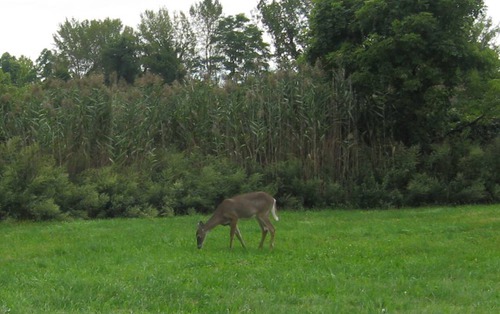 Spring is still weeks away, but Rye residents are already thinking about how to keep out or get rid of those pesky plant predators that will be making unwelcome house calls when the backyard buds, blossoms, and shoots begin bursting out and beckoning — white-tailed deer.
Spring is still weeks away, but Rye residents are already thinking about how to keep out or get rid of those pesky plant predators that will be making unwelcome house calls when the backyard buds, blossoms, and shoots begin bursting out and beckoning — white-tailed deer.
By Bill Lawyer
 Spring is still weeks away, but Rye residents are already thinking about how to keep out or get rid of those pesky plant predators that will be making unwelcome house calls when the backyard buds, blossoms, and shoots begin bursting out and beckoning — white-tailed deer.
Spring is still weeks away, but Rye residents are already thinking about how to keep out or get rid of those pesky plant predators that will be making unwelcome house calls when the backyard buds, blossoms, and shoots begin bursting out and beckoning — white-tailed deer.
It was standing-room-only at the Meeting House last week for a lecture on coping with deer in the garden by Westchester horticulturalist and author Ruth Rogers Clausen.
Clausen, a lively and knowledgeable speaker, started things off by asking, “How many of you are here because you’re having problems with deer?”
The response was vocal and unanimous – everyone was!
One person in the audience said the deer have gotten so bold that she’s seen them eating the bird seed right out of her feeder – standing on their hind legs, holding on with their “dainty feet” to get every last morsel.
Cornell University researchers report that the deer population is up due to last year’s mild winter.
Somewhat ironically, the program had originally been scheduled for early November of last year, but had to be postponed due to damage caused by Sandy. The consensus among participants was that the storm did nothing to slow down or deter the ever-growing number of deer that have made a home for themselves in the 10580 zip code.
Before getting down to the nitty-gritty of specific plants, Clausen covered basic strategy. “First,” she said emphatically, “ don’t put out a welcome mat for them.” She said that frequently, homeowners plant long rows of hosta — a five-star deer foraging favorite — from the street right up to their doorstep. If you have to have hosta, she added, at least spread them out and surround them with plants on the deer-reject list.
That led to some generalities about what deer don’t like. In her popular book, “50 Beautiful Deer-Resistant Plants: The Prettiest Annuals, Perennials, Bulbs, and Shrubs that Deer Don’t Eat,” Clausen offers a Deer Resistance Scale, rating of the plants in the book on a scale of 7 to 10, with 10 being the most resistant. No plant with lower than a 7 rating is included.
The rating criteria are:
7: Sometime nip flowers but let foliage alone;
8: Sometimes eat flowers but let plants alone;
9: Sometimes eat spring foliage;
10: Usually let plants alone.
Among the types of plants getting the highest resistance ratings are grasses, scented plants – particularly sages (salvia) and oregano – and silver-colored plants such as deadnettle, in the Lamium genus.
Clausen encouraged people in the audience to compare notes with their neighbors. A native of South Wales, she recalled her amazement when moving to the United States and finding so many species of plants growing wild that could only be grown as annuals back in Britain.
In a discussion after the program, several people exchanged information about various commercial deer repellants. While Clausen said that some have been seen to be effective, they must be re-applied after any rainstorm.
As troublesome as deer in our backyards may be, they are not as serious a problem as the deer-car collisions that occur – many along Playland Parkway, where cars drive too fast to be able to react when deer come bounding across the marshy area between the Post Road overpass and Milton Road.
Unfortunately, one of the items cut in the Westchester County budget for 2013 was the position of coordinator of the County’s deer management project. Oh, deer!















